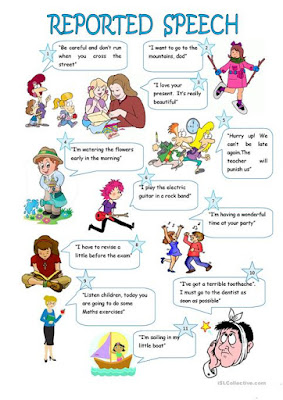REPORTED SPEECH - MODAL VERBS AND PAST PERFECT

REPORTED SPEECH - MODAL VERBS AND PAST PERFECT Las reglas del Reported Speech en inglés Hay varias reglas para el uso del reported speech en inglés. Pero primero, dejamos claro qué es. El reported speech también se llama estilo indirecto. Y así es lo contrario de estilo directo, que utiliza comillas. La versión corta: estilo directo es exactamente – textualmente – lo que dice alguien. Reported speech es una forma de contarlo a otra persona. Un ejemplo sencillo… Estilo directo: “I’m on my way”, said Tom. Estilo indirecto / reported speech: Tom said he was on his way. Otras reglas: generalmente, el estilo indirecto utiliza un “paso atrás” en el tiempo. O sea, que cambiamos el tiempo verbal al pasado. Entonces… Presente simple cambia a pasado simple. Can cambia a could. Will cambia a would. Presente perfecto cambia a pasado perfecto. Pasado simple cambia a pasado perfecto. Direct Speech Decir exactamente lo que alguien h...


